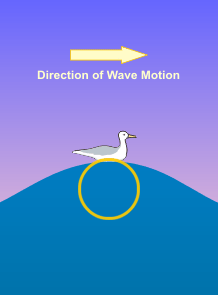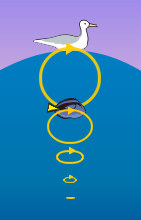Anatomy of a Wave
 The highest part of the wave is called the crest. The lowest part is called the trough. The wave height is the overall vertical change in height between the crest and the trough and distance between two successive crests (or troughs) is the length of the wave or wavelength.
The highest part of the wave is called the crest. The lowest part is called the trough. The wave height is the overall vertical change in height between the crest and the trough and distance between two successive crests (or troughs) is the length of the wave or wavelength.
While one normally associates an up and down motion with the passage of each wave. Actually, a circular motion occurs. It is this orbital motion of the water (or objects on the surface of the water) that causes an object to bob up and down, forward and backward as waves pass under it.
 But even this motion is not exactly circular but is trochoidal (line form traced by a point on a rolling wheel). While the motion in a wave over deep water move is an almost closed circular path there is a tiny forward motion with the passage of each wave, particularly in large waves. But even this motion is not exactly circular but is trochoidal (line form traced by a point on a rolling wheel). While the motion in a wave over deep water move is an almost closed circular path there is a tiny forward motion with the passage of each wave, particularly in large waves.
 Also, in deep water, the motion changes as the depth increases fairly rapidly. The trochoidal shape at the surface flattens with increasing depth as well as a decrease in the total motion. This flattening of motion/decreasing size continues with increasing depth until all that remains is a small back and forth movement and even that will cease to be noticed which occurs at one-half of the waves's total length. For shallow water waves, the same flattening in the motion occurs but there is no decrease in the forward/backward motion. Also, in deep water, the motion changes as the depth increases fairly rapidly. The trochoidal shape at the surface flattens with increasing depth as well as a decrease in the total motion. This flattening of motion/decreasing size continues with increasing depth until all that remains is a small back and forth movement and even that will cease to be noticed which occurs at one-half of the waves's total length. For shallow water waves, the same flattening in the motion occurs but there is no decrease in the forward/backward motion.
The speed at which a wave moves through the water is dependent on the wave's length and the depth of the water. Generally, the longer the length of the wave the faster is moves through the water. Tsunamis can have extremely long wave lengths (60 miles/100 km or more) and thus move around 550 mph (900 kph).
As a deep water wave reaches shore, at the point where the depth of the water is one-half of the wave's length, it begins to "feel" the bottom. The wave will slow down, grow taller and become shaped like peaks. These wavepeaks reach a height where they become unstable and, moving faster than the water below, they break forward. |
|





